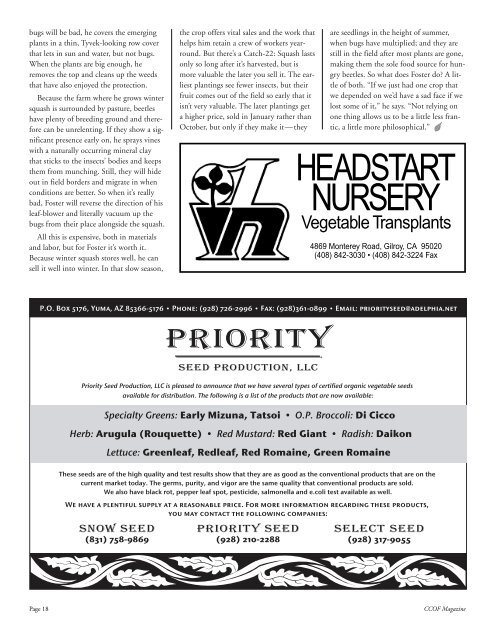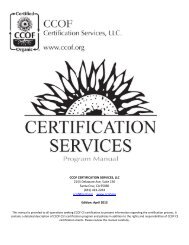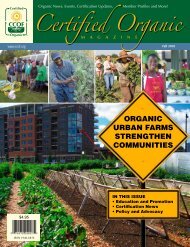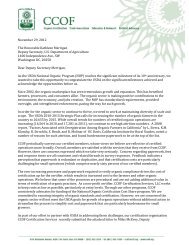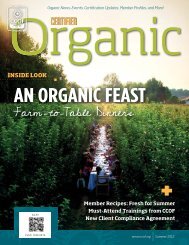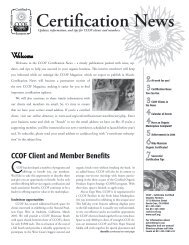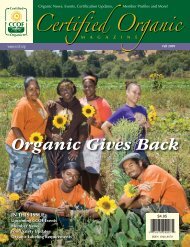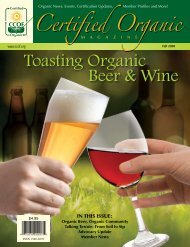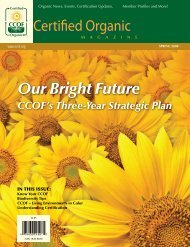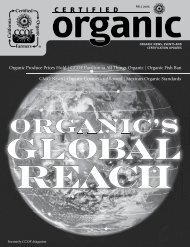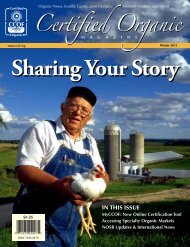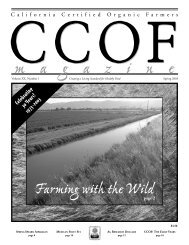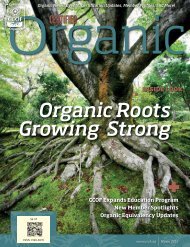ugs will be bad, he covers the emerg<strong>in</strong>gplants <strong>in</strong> a th<strong>in</strong>, Tyvek-look<strong>in</strong>g row coverthat lets <strong>in</strong> sun and water, but not bugs.When the plants are big enough, heremoves the top and cleans up the weedsthat have also enjoyed the protection.Because the farm where he grows w<strong>in</strong>tersquash is surrounded by pasture, beetleshave plenty of breed<strong>in</strong>g ground and thereforecan be unrelent<strong>in</strong>g. If they show a significantpresence early on, he sprays v<strong>in</strong>eswith a naturally occurr<strong>in</strong>g m<strong>in</strong>eral claythat sticks to the <strong>in</strong>sects’ bodies and keepsthem from munch<strong>in</strong>g. Still, they will hideout <strong>in</strong> field borders and migrate <strong>in</strong> whenconditions are better. So when it’s reallybad, Foster will reverse the direction of hisleaf-blower and literally vacuum up thebugs from their place alongside the squash.All this is expensive, both <strong>in</strong> materialsand labor, but for Foster it’s worth it.Because w<strong>in</strong>ter squash stores well, he cansell it well <strong>in</strong>to w<strong>in</strong>ter. In that slow season,the crop offers vital sales and the work thathelps him reta<strong>in</strong> a crew of workers yearround.But there’s a Catch-22: Squash lastsonly so long after it’s harvested, but ismore valuable the later you sell it. The earliestplant<strong>in</strong>gs see fewer <strong>in</strong>sects, but theirfruit comes out of the field so early that itisn’t very valuable. The later plant<strong>in</strong>gs geta higher price, sold <strong>in</strong> January rather thanOctober, but only if they make it—theyare seedl<strong>in</strong>gs <strong>in</strong> the height of summer,when bugs have multiplied; and they arestill <strong>in</strong> the field after most plants are gone,mak<strong>in</strong>g them the sole food source for hungrybeetles. So what does Foster do? A littleof both. “If we just had one crop thatwe depended on we’d have a sad face if welost some of it,” he says. “Not rely<strong>in</strong>g onone th<strong>in</strong>g allows us to be a little less frantic,a little more philosophical.”HEADSTARTNURSERYVegetable Transplants4869 Monterey Road, Gilroy, CA 95020(408) 842-3030 • (408) 842-3224 FaxPage 18<strong>CCOF</strong> Magaz<strong>in</strong>e
EDUCATIONPhoto courtesy of Life Lab.By Kenny Swa<strong>in</strong>, Market<strong>in</strong>g & Communications Assistant“The best and mostbeautiful th<strong>in</strong>gs <strong>in</strong> theworld cannot be seenor even touched.They must be feltwith the heart.”~ Helen KellerPARENTS, EDUCATORS, AND SCHOOLchildren <strong>in</strong> Santa Cruz County havea new educational resource to celebrate!A collaborative effort between LifeLab Science Program, New Leaf CommunityMarkets, The Center for Agroecologyand Susta<strong>in</strong>able Food Systems(CASFS), and Community Alliance withFamily Farmers (CAFF) has develop aprogram called “Field-to-Market-to-You.”The field trip program is split <strong>in</strong>to two agegroups: one for students <strong>in</strong> the fourththrough six grade; and a new program forsecond and third grade students whichmeets many state education standards forthe social sciences. Each program <strong>in</strong>cludesa two-hour <strong>in</strong>-class session, and a twohourgrocery store exploration at New LeafCommunity Markets. The second andthird grade courses will focus on the richagricultural history of Santa Cruz County,an overview of significant historical figures,and a scavenger hunt. The fourththrough sixth grade program explores thelife cycle of food production, benefits oflocal and non-local foods, nutrition, conservation,and consumer consciousness.The all encompass<strong>in</strong>g “TV culture” andmass media market<strong>in</strong>g campaigns are poison<strong>in</strong>gour culture. The result is that consumershave become mis<strong>in</strong>formed aboutand disconnected from the land and thepeople that grow their food. If we can educateour children and provide them withthe tools necessary to understand the connectionbetween the health of the soil andthe health of the people, they become thecure—<strong>in</strong>formed bus<strong>in</strong>ess leaders, policymakers,and consumers of tomorrow. SteveEdwards, a teacher at The Aptos Academy,whose class will be participat<strong>in</strong>g <strong>in</strong> theprogram, remarked, “Young people needto learn how to make good choices aboutthe food they eat at school and at home.The “Field-to-Market-to-You” programwill make students aware of the k<strong>in</strong>ds of<strong>in</strong>formation they can look at to help themmake decisions. This is a good first step <strong>in</strong>help<strong>in</strong>g students realize they have to takeresponsibility for their health and thehealth of the planet.” Giv<strong>in</strong>g studentshands on experience outside the classroomis paramount to understand<strong>in</strong>g the conceptstaught <strong>in</strong> theclassroom.The “Field-to-Market-to-You”program is part ofa Central Coastcommunity-basedeffort to <strong>in</strong>tegratenutrition and foodsystems education withschool gardens, schoolcafeterias, local farms,and communitymarkets. “Field-to-Market-to-You” is runby Katie Davis, anexperienced New LeafCommunity MarketsCommunity Educatorand former Life Lab<strong>in</strong>tern. Katie br<strong>in</strong>gs adeep concern for theenvironment and a loveof teach<strong>in</strong>g children toeach session she leads.“I believe that we allhave the power to createpositive change <strong>in</strong> our community andsociety. I feel that educat<strong>in</strong>g children andempower<strong>in</strong>g them to form op<strong>in</strong>ions andmake their own decisions is the mostprofound step I can take toward positivechange,” said Davis. “Field-to-Market-to-You” is offered throughout the school year.Teachers, students and parents who wouldlike to register or would like more <strong>in</strong>formationabout this and other programsoffered by the Life Lab may visitwww.lifelab.org or call 831-459-2001.W<strong>in</strong>ter 2003–2004 Page 19


